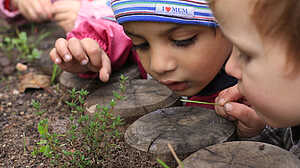Education prior to the change of teeth
In the early years of life children first learn through their own movements and the use of their senses to form and take hold of their own body. The will to learn which they have brought with them from the prenatal realm expresses itself in a tremendous urge to move and be busy. Their movement organization is activated by every impression they receive through their senses.
The term we use to describe the link between sensual experience and will activity is «imitation». For the children, learning at this stage is thus a matter of experiencing their new world through their senses and then using play as their means of absorbing those experiences.
Current brain research has repeatedly shown that this activity directly influences the development of the body. It is the sense impressions which help to develop both the functioning of the sense organs and thus also the maturing processes in the brain. (Herman Haken, Maria Haken-Krell. «Erfolgsgeheimnisse der Wahrnehmung», Berlin 1994; The secrets of perception, German only). Steiner formulated this as follows in 1907: «Just as the muscles in the hand grow strong when they do work suited to them, so are the brain and the other organs set on the right course if they receive suitable impressions from their surroundings» (Rudolf Steiner, «The Education of the Child and Early Lectures on Education», Anthroposophic Press, 1996).

This leads us to ask ourselves:
- How can we give children an environment that enables them to have primary sensual experiences of this kind?
- How can we protect them against sensual overload?
- What are we offering them that is worth imitating?
Since children are in human environment it is up to those who educate them both to protect them and to act as models worthy of imitation. Anything simple and natural, including what they are given by way of toys, provides far better stimulus for their own inner activity than does a technically perfect environment.
(Source: Heinz Zimmermann, Waldorf-Pädagogik weltweit, 2001, Berlin)